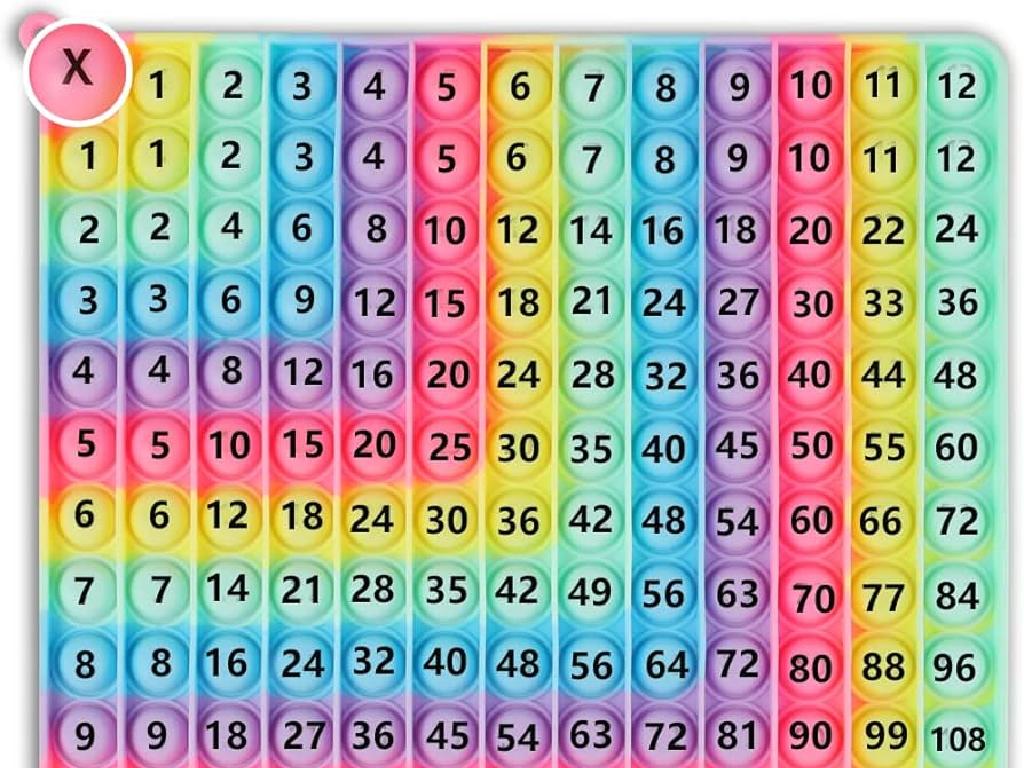Holi
Subject: Social studies
Grade: Second grade
Topic: Cultural Celebrations
Please LOG IN to download the presentation. Access is available to registered users only.
View More Content
Exploring Cultural Celebrations: Holi
– What are cultural celebrations?
Events that honor traditions and customs of a group.
– Celebrating diverse cultures
To learn, respect, and enjoy different ways of life.
– Today’s focus: Holi!
Holi is a vibrant festival of colors celebrated in spring.
– Significance of Holi
Holi marks the victory of good over evil and the arrival of spring.
|
This slide introduces the concept of cultural celebrations, emphasizing their importance in honoring the traditions and customs of various groups. It’s crucial to convey to second graders that celebrating different cultures allows us to learn about and respect the diverse ways people live and express joy. Holi, as a special celebration, is a perfect example of a cultural festival that is colorful, fun, and has deep meaning. It’s celebrated by throwing colored powders and signifies the triumph of good over evil, as well as the welcoming of the spring season. Teachers should encourage students to think about what celebrations they participate in and how they might be similar or different from Holi.
Exploring Holi: The Festival of Colors
– Holi is a vibrant festival from India
– Also known as the ‘Festival of Colors’
– It celebrates the start of spring
– Symbolizes new life and energy
– People play with colors and water
– Throwing powders represents joy
– It’s a time for fun and new beginnings
|
Holi is a traditional Indian festival that welcomes the spring season and is often referred to as the ‘Festival of Colors’. It’s a time when people come together to celebrate new life and energy that spring brings. During Holi, participants throw vibrant colored powders and splash water on each other as a way to play and enjoy the festive spirit. This activity symbolizes joy, friendship, and forgiveness. It’s a wonderful opportunity to teach students about cultural diversity and the significance of celebrating new beginnings. Encourage the children to think about what spring means to them and how they celebrate joy and new life in their own lives.
The Story of Holi: Good Triumphs Over Evil
– Holi’s origin: Holika and Prahlad
– A legend where good wins against evil
– Lesson: Good beats evil
– Think of similar good vs. evil stories
– Maybe a fairy tale or superhero story?
– Share your stories with the class
– We’ll discuss as a group next time!
|
This slide introduces the cultural celebration of Holi through the story of Holika and Prahlad, which is a great way to discuss the theme of good versus evil with the class. Encourage the students to think of other stories they know where good wins over evil, such as fairy tales or superhero stories, to make the concept relatable and engaging. This will help them connect the festival to broader moral themes and understand the significance of the celebration. In the next class, create a discussion segment where students can share the stories they thought of and explore the common theme of good triumphing over evil.
How is Holi Celebrated?
– Gathering for color play
– People meet outdoors to throw colored powders
– Dancing, singing, and feasting
– Enjoying music and special dishes like gujiya
– Time for forgiveness
– Letting go of old grudges and starting fresh
– Making new friends
– Welcoming others into our circle
|
This slide aims to explain the celebration of Holi to second-grade students. Holi is a vibrant festival where people come together in open spaces to play with colors, symbolizing joy and the arrival of spring. Traditional songs and dances are performed, and everyone enjoys special foods, which are an important part of the festivities. Holi also represents a time to forgive past disagreements and to make new friends, emphasizing the themes of reconciliation and community. Encourage the students to think about how they can apply these themes in their own lives, such as by forgiving a sibling or making a new friend at school.
Colors of Holi: What Do They Mean?
– Red symbolizes love and festivity
– Blue represents Lord Krishna
– Krishna is often depicted in blue and is revered in the festival
– Green marks new beginnings and nature
– Spring season is about starting fresh, just like green
– Safety tip: Use non-toxic colors
– It’s important to play safely with colors that won’t harm your skin
|
This slide introduces the students to the vibrant festival of Holi and the significance of its colors. Red is a color of love and is often used during celebrations to signify joy and happiness. Blue is associated with Lord Krishna, a major deity in Hinduism, who is traditionally depicted with blue skin. Green represents new beginnings, much like the spring season when Holi is celebrated, symbolizing nature and fresh starts. Emphasize the importance of safety by using non-toxic colors to ensure a fun and safe celebration. Encourage the children to discuss the colors they would like to use during Holi and what those colors mean to them personally.
Holi Around the World
– Holi: A global celebration
– Not just in India, but worldwide
– Many countries have Holi festivals with colors and joy
– A festival of fun and unity
– People come together to play, laugh, and dance
– Sharing Indian culture globally
– Holi introduces Indian traditions to new friends
|
This slide aims to show the students how Holi, the festival of colors, is celebrated not just in India but around the world, emphasizing its global appeal and the way it brings people together. Highlight the aspects of fun, community, and cultural exchange that Holi promotes. Encourage students to think about how sharing traditions can help us learn about and appreciate different cultures. You can discuss how festivals like Holi can create a sense of togetherness and joy among diverse groups of people. Ask the students if they have ever participated in Holi or a similar festival and to share their experiences.
Class Activity: Our Mini Holi Festival
– Create safe ‘Holi’ colors with chalk
– Pair up and color each other’s hand
– Take turns with your partner
– Be gentle and respectful
– Enjoy our classroom Holi celebration
– Share the joy of Holi in class
|
This activity is designed to give students a hands-on experience of the Holi festival, which is celebrated with colors in many parts of the world. Provide chalk powder for students to create their own Holi colors. Emphasize the importance of being gentle and respectful while applying color to their partner’s hand. This is a great opportunity to discuss the significance of Holi and how it is celebrated. Possible activities: 1) Discuss the history of Holi and its cultural significance. 2) Have students create Holi greeting cards. 3) Write about what colors mean to them. 4) Share Holi stories. 5) Sing Holi songs. Ensure that the activity is supervised and that all materials used are safe and non-toxic.
Reflecting on Holi: Lessons and Respect
– What we learned about Holi
– Holi celebrates spring and unity
– Holi’s message in our lives
– Sharing, caring, and forgiveness
– Cleaning up is part of the fun
– Working together makes it easier
– Respecting all cultures
– Every culture is important and valuable
|
This slide aims to wrap up the lesson on Holi by reflecting on its significance and the values it teaches. Holi, the festival of colors, is not only about celebrating the arrival of spring but also about unity, friendship, and the triumph of good over evil. Encourage students to discuss how the festival’s message of love and forgiveness can be applied in their daily lives, such as being kind to their friends and family. Emphasize the importance of teamwork in cleaning up, which is also a part of the festival’s spirit. Lastly, reinforce the idea that every culture has its unique celebrations and that we should respect and appreciate the diversity around us. This discussion will help students understand the importance of cultural sensitivity and awareness.






